Cycling Holidays – Dordogne at a Glance
Welcome to the cradle of prehistory.
The region of haunting cave paintings, cliff-top castles, impressive bastides, rocky vineyards and amazing rivers. Where better to wind through history on a bike in the warm French sunshine?
We can’t pinpoint which moment in history you’ll find the most appealing, but we’ve tried to give a little background to a few of the favourite places included in our self guided bike tours of France.
Find out more about cycling holidays in the Dordogne
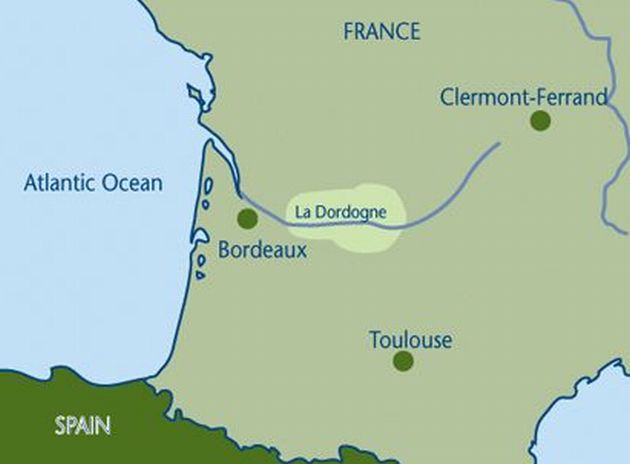
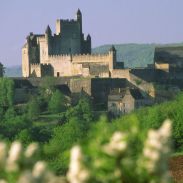
Beynac
Dominated by a sheer cliff rising some 150m above the Dordogne river, this is another of those jaw-dropping spots.The castle and chapel cling to the rock-face and tower high above the valley. The view from the top is undoubtedly one of the most striking vistas in the Périgord region.
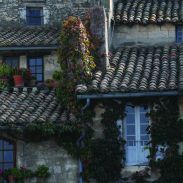 Bergerac
Bergerac
Essentially a modern town with a very attractive ‘vieille ville’, this was once a flourishing port for the wine trade in particular. The name for the surrounding area of the Dordogne – the Périgord Pourpre (purple) – underlines the importance of the vine in this part of the region and the local cellars are certainly worth sniffing out. Fittingly enough, there’s a small museum in the heart of the old town dedicated to the history of viticulture and barrel making, and another in the rather splendid 17th C. Maison Peyrarède all about local tobacco production including interesting collections of pipes. On the market square there is statue of Rostand’s fictitious character, Cyrano de Bergerac – nose and all.
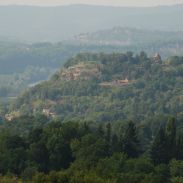
Domme
Once a bastide, this old town sits on a promontory soaring above the Dordogne river. Gatehouses, 13th C. ramparts, tiny narrow streets lined with ancient houses and a picturesque timbered market hall are all worth a good gaze.
Gourdon
Encircled by ramparts, this town sits on a hill and boasts a fortified church with remarkable panelling and stained glass windows.
Le Bugue
On the banks of the River Vézère surrounded by wooded hills, the town was completely transformed in the 19th C. huddled around its churches of St. Marcel and St. Supplice. Le Village du Bournat is a living rural life museum with local craftsmen and reconstructed period properties. Le Bara-Bahau caves reveal prehistoric drawings and engravings probably undertaken by ancestors in the Magdalenian era, some 15,000 years ago.
Les Eyzies
Often referred to as the ‘Cradle of Prehistory’, this site lies above the valley of the Vézère amidst limestone cliffs pitted with caves. It’s here that the first discoverer of prehistoric caves drawings was made. Tourists have flocked here ever since and the National Museum of Prehistory is certainly a very worthy attraction. It is housed in the château of the Barons of Beynac.
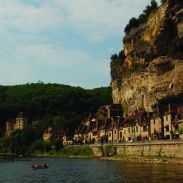
La Roque Gageac
A distinct contrast to the rocky cliffs of adjacent parts of the valley, here the river meanders lazily between green banks. A place to paddle perhaps with canoe or just feet.

Lascaux Caves
‘Prehistory’s Sistine Chapel’ – a fantastic insight into the lives of our European ancestors. A unique collection of prehistoric wall paintings painted by Cro-Magnon man some 17,000 years ago. The pigment pictures depict animals such as reindeer, bison, bulls and cows. There are also mysterious signs. The actual caves were closed to the public in 1963 to prevent deterioration, however Lascaux II, constructed nearby, is an almost perfect replica of part of the caves and their paintings including the very clear image of the great bull. A fascinating prehistoric art centre has been created at Le Thot a few miles away.
Montignac
With a number of wooden balconied houses leaning forward over the river and a great weekly market, this is tends to be the main stopping point for visitors to the Dordogne’s prehistoric attractions.
Rocamadour
A real must-see, this one-street village in the narrow Alzou gorge sits at the foot of an enormous rock, famous for its medieval sanctuaries. Take the 143 steps up to the fort or the Bishop of Tulle’s palace from where you can get to the mystical collection of crypts all built on different levels. A 12th C. external tunnel and steeply winding path leads up to the Stations of the Cross, the 14th C. château and really stunning views of the whole site.
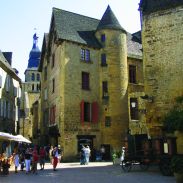 Sarlat-le-Canéda
Sarlat-le-Canéda
An old town with many very picturesque quarters packed with
15-16th C. houses. Remarkably homogeneous in terms of architecture – the oldest part is around the Place du Peyrou, site of a 16th C. former bishop’s palace which is now a theatre and the church of St. Sacerdos, a former Romanesque abbey rebuilt in the 16-17th C. To the north of the town on the Temniac hill sits a
12th C. romanesque church close to the remains of the château of the bishops of Sarlat – a truly beautiful setting.
Souillac
At the confluence of the Corrèze and the Dordogne, this little town has a remarkable 12th C. church with amazing if somewhat macabre Romanesque sculptures. If you can get past the seething mass of beasts chewing away at each other, the sculpture of Isaiah has an impressive modernity about it, such is the fluidity of form. Behind the church the museum of automaton is worth a quick visit. Virginia Woolfe stayed here in 1937.





